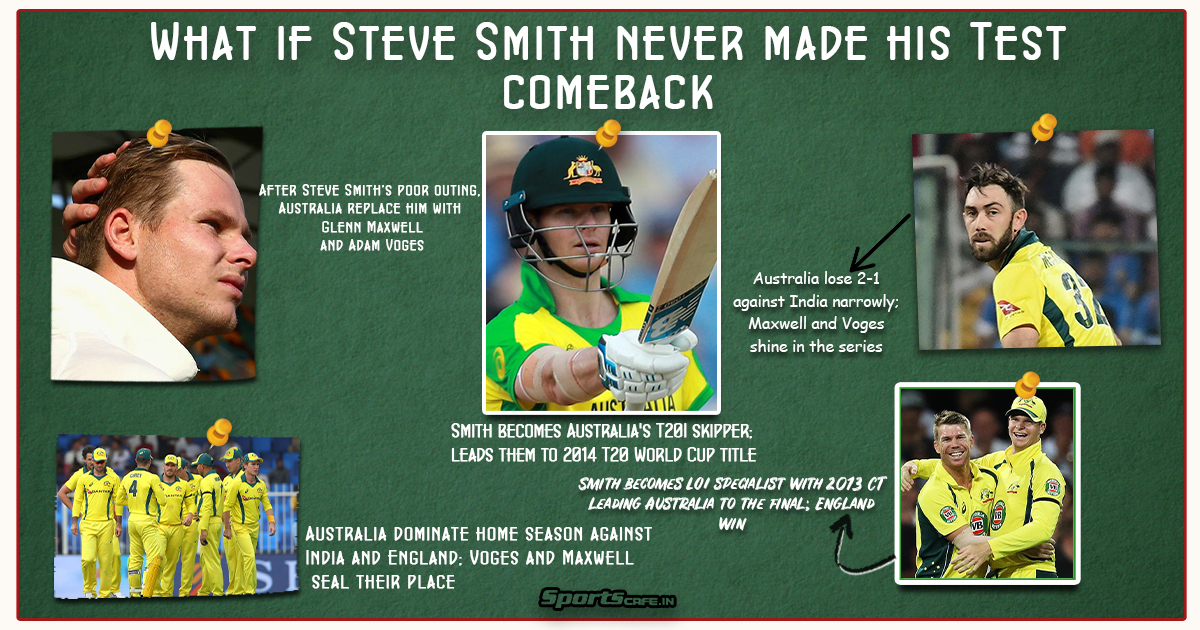What if Wednesday | What if Steve Smith never made his Test comeback against India

What if in a parallel world - would Smith have led Australia earlier?
|SportsCafe
England complete an incredible 3-1 win over Australia to reclaim the Ashes but what does the future hold for Australia? Will Steve Smith go on to play another Test after a shocker of a series with the ball in his hand?
It is 2011, just after one of Australia’s appalling times in International cricket, they have just now lost 3-1 to their rivals in their own backyard, bloody hell! 13-0-67-0 is what Steve Smith manages to get in the Test and his place is very well discussed as the one where Australia will be seeking a replacement. What happens next?
Following the loss against England, the Australian selectors have assembled to name the squad for their next tour - against Sri Lanka away from home. One of the biggest failures of the Ashes series, Steve Smith’s name pops up for discussion and within minutes, the selectors anoint that the leg-spinner is not going to tour the Asian country, picking two debutants - Glenn Maxwell and Adam Voges - in the setup.
Adam Voges, who has idolised Ponting all his life, receives his cap from the Australian skipper, after having scored 757 runs in the Sheffield Shield in 2011/12, at an average of 54. Making his debut at #6, the right-hander scores peachy 68-ball 48, to propel Australia’s score to 300 after their first innings. However, with the Australian pacers struggling to pick up wickets, Ponting hands the ball over to Voges, similar to how he gave Clarke the ball in Sydney to set the wickets tumbling.
Alongside Lyon, Voges’ left-arm picks up 3 wickets in just 5 overs, to dismiss the hosts to 105 in the first innings, which essentially kick-starts his career. In just his first game, the right-hander leaves a visible impact on the selectors, which prompts them to pick Glenn Maxwell instead of Trent Copeland for the second Test. Maxwell, similar to Voges, picks apart the Sri Lankan batting order in an outstanding whitewash for the visitors in the Island nation - with the Victorian getting the plaudits as the man of the match for his figures of 7/67 and his 68 crucial runs.
However, the biggest Test awaits for the two newcomers - an away series against India where Australia haven’t had a positive result since the early 2000s. In just the first Test, after being reduced to 131/4, the visitors wanted an innings of extraordinary from Voges and Maxwell, who were picked ahead of Burns. While Voges walked back for a 30-ball 24, Maxwell’s counter-attacking innings alongside Clarke’s aggression propels the visitors to a 400+ total in Chennai. A combination of Lyon-Maxwell-Voges with James Pattinson, Peter Siddle and Starc ensures that Australia come away with a massive 50-run lead after the first innings.
Despite the collapse on day three, Australia set India a target of 270 runs in the fourth innings on a tricky pitch at Chepauk. Early on, the timely introduction of Lyon sets the game up in Australia’s favour as the off-spinner picks up a quick fifer, with Pattinson running down through the tail-enders to set up a memorable victory for Australia away from home. However, after an impressive display in Chennai, a combination of inability to play spin and Michael Clarke’s injury leads to Australia losing the series 2-1, which puts Shane Watson, Matthew Wade and Ed Cowan’s places in doubt, also essentially sealing the future for Joe Burns, Voges and Maxwell.
That combined with their shambles in the Ashes put the entire team in focus, barring the occasional brilliance from Burns, Voges and Maxwell while Smith remains booted out of the Test setup.
Ahead of the Champions Trophy, however, Smith’s name has consistently been making the buzz, with the all-rounder having been axed from the Test squad. The all-rounder has shown enough in the white-ball format to keep the selectors afloat in giving him another chance for the Champions Trophy, a tournament that they earmarked as a squad selection before the home World Cup. Despite starting the tournament with a string of poor scores, Smith has been presented the opportunity of showcasing his talent in the do-or-die encounter against Sri Lanka in Australia’s last group game.
With Shane Watson’s poor form, Australian management decides to promote Steve Smith as the opener for the crucial fixture, after reducing Sri Lanka to 253/8. Smith thwarts the challenge of facing the new ball, dominates exceedingly well against the spin and leads Australia to a monumental run-chase with an aggressive century, pushing the Kangaroos to the last stage of the competition, where they face India. India, who have been one of the stronger suits in the tournament would now face their ICC nemesis Australia in a rematch of the 2011 World Cup quarterfinal.
Batting first at the smaller stadium in Cardiff, Australian openers Shane Watson and Philip Hughes get off to the best start possible, adding 60 runs between them. However, once the first wicket falls, Australia finds themselves in a rather string of trouble. With no signs of discomfort against spin or pace, Smith’s uncanny footwork tackles the Indian challenge seamlessly, taking Australia to a total of 320 after 50 overs, in deteriorating conditions.
Mitchell Johnson blows open the Indian top-order, tackles the middle order as India find themselves in a petty state of affair, at 30/3. With Virat Kohli still at the crease, the Indian were hopeful of their future skipper to put on an innings. Kohli, who hasn’t inspired the team yet, fails yet another time, with just a 70 against Australia as the short-ball comes in like a nightmare to the Indian middle-order. Smith’s innings quashes MS Dhoni’s hopes of a triple ICC title while making the headlines the next day. Despite all the heroics, however, Australia fall short of the hosts England in the final, wherein in a rain-curtailed encounter, the hosts walk away as the victors.
Even though Australia lose against arch-rivals in the final, Cricket Australia decides to award Smith and his contribution with the leadership of leading the side in Clarke’s absence in limited-overs. Elsewhere, Mickey Arthur and the management are keen on giving an entire series to Joe Burns in the middle of the batting order alongside Voges and Maxwell. And at the top of the order, the Australian management award debuts to Michael Klinger to partner with David Warner. The duo put on a partnership in dazzling fashion against England at Gabba, with a 100-run partnership while the middle-order scores 250 between them to set up a first innings total of 430 against England. Incapable of handling the bounce and pace, England fold twice in two days, for under 300 runs to give the first Test to the hosts.
Nothing dramatic unfolds in the next four Tests, with Klinger, Warner, Voges, Maxwell and Clarke all amongst runs for the dominant Australian side, who sweep past England 5-0 with relative ease, putting the pressure back on the visitors to rebuild their Test side, a similar situation that Australia found themselves earlier in the same year. While Australia endured what was a tough season, the 2014 T20 World Cup served as the biggest indicator of where the white-ball team was heading, something that garnered the interest of the keen eyes of the selectors.
With the tournament in Bangladesh, Australia decide to shake a few things up - most notably handing the captaincy over to young blood Steve Smith, who showcased his run prowess in the white-ball format. Alongside that, the management also hand caps to Andrew Tye and Adam Zampa, two breakthrough performers in the Big Bash League, giving the domestic competition a good heads-up for the players. However, with Johnson being ruled out just days before the start, the management recall Bollinger into the setup, as Australia look well prepared to come away with the goods.
While Bollinger and Watson account for first two wickets, Zampa runs through the Pakistan middle-order with a spell of dominance - 2/10 - as Tye patches up the rest of the innings with his variations. Despite Umar Akmal’s brilliance, Pakistan could only post 150 runs on board, which eventually is chased rather easily by the opening duo of Warner and Finch before Smith’s 13-ball 28 seals the game. In the second game against West Indies, Australia put on 178 runs on board, putting the West Indies under extreme pressure. While Gayle and Dwayne Smith put on a show, it wasn’t quite enough for the Windies, as Zampa’s masterful bowling helps Australia to their second one, which also seals their place in the next round.
Going against similar opposition in the form of Sri Lanka, Smith’s uncanny captaincy comes to the fore, when he gives the ball to Glenn Maxwell against left-handed Kusal Perara, a decision that ultimately tilts the game in Australia’s favour. From thereon, the duo of Dilshan and Jayawardene struggle against Starc’s left-handed bowling, as Australia dismiss Sri Lanka for just 130 runs, with an all-important chase coming up. With Malinga’s in-darters, Australia lose both openers in just the first over but Brad Hodge, Smith and Maxwell ensure that Australia keep their record intact, unbeaten in the tournament.
One last hurdle, they face India, who they beat just a year ago. High on confidence, India opt to bowl first under extraordinary circumstances. Australia, with their tails up high on form, swat the bowling order and put on a truly spectacular show, with 180 runs on the board, as the Indian bowling unit comes under extreme pressure. Despite the likes of Kohli and Rohit in the lineup, only Yuvraj manages to get any sort of good score, with a 40 as India crash to yet another defeat - two in two years against the Australians. A merry Smith, who was on the edge of being ousted from the national team across formats becomes an Australian hero, leading the side to their only competition that they have never won. But in an oops moment, he drops the trophy while in a hurry to celebrate.
